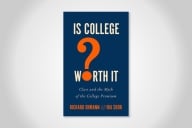You have /5 articles left.
Sign up for a free account or log in.
Just what, really, is the overall impact of intercollegiate athletics on an institution? How can we accurately calculate its true cost?
I’ve been thinking about this for the past several days, prompted by John Warner’s post about the inequity of student fees subsidizing intercollegiate college sports when colleges struggle to pay for essential educational assets and many students are over-burdened with debt.
I wonder whether the public — and alumni and institutional sports fans in particular — will be able to overcome their loyalty to their favorite college team and discuss the issues around intercollegiate sports rationally, recognizing that many of the programs they love and support are, in reality, very expensive fringe benefits — more costly and with much greater risk to an institution than climbing walls and lazy rivers.
Questions about cost
Determining the true cost of intercollegiate athletics costs isn’t just about adding up direct expenses like staff salaries, the cost of facilities and their upkeep, and travel expenses. There’s a lot more involved.
As Warner points out, students subsidize programs at
“ … the less well-heeled schools with smaller programs where the burden falls most heavily on institutional funds. UC-Riverside’s sports program is over 90% subsidized. There are almost 90 programs in the USA Today data that are over 70% subsidized.”
To be fair, there is a potential upside to intercollegiate athletics at these schools— for those who win championships. There is evidence that championship wins boost student recruitment overall, contributing to an increased number of applications and thereby allowing institutions to be more selective. There may also be revenue implications of this recruitment, of course. And let’s not forget that some colleges seeking to recruit more male students have started intercollegiate athletic programs specifically for that purpose.
Of course, while many of the programs students subsidize won’t win championships, there is an undefinable value of having a team to rally around. For many students, intercollegiate competition enhances undergraduate life and is an important part of an experience that alumni value and support with their dollars.
It’s much harder to calculate the potential impact and costs that an athletics-related scandal can have on an institution. Of course, many scandals have nothing to do with intercollegiate athletics. But we’ve seen a number of these emerge and, in the era of #MeToo, may see more. Here, potential costs include a decline in applications or donations and damage to an institution’s reputation.
A hit to reputation
Scandals that emerge within an institution, and are shared on social media, have an impact on institutional stakeholders. But those that find their way into mainstream media can cause serious financial damage.
Among the financial hits an institution can take from a scandal is a drop in admissions. In a Harvard Business School working paper that looked at scandals overall, not just those related to athletics, researchers calculated “ … that a scandal mentioned once in The New York Times led to a 5 percent dip in applications the following year. Meanwhile, a scandal mentioned in more than five New York Times articles led to a 9 percent dip.” The researchers also pointed out that “ … colleges are unlikely to have a second scandal in the following years ….This suggests that after a scandal, the campus actually may be less risky.”
That’s a big impact on revenue for a tuition-dependent institution.
How may donations be affected by a scandal? The short answer is, it may be hard to tell. Jillian Berman reported in Market Watch on research by Texas A&M faculty member Jonathon Meer: “Factors that typically influence alumni donations include whether the donor was part of the majority social culture on campus, a school’s involvement in athletics and whether the school invests in creating a habit among young alumni to donate ....”
For most institutions, it’s also difficult to calculate the effect a scandal has on reputation as it continues to undermine the efforts of faculty and administration to move on and focus on other issues. A scandal and its fallout may roil a campus for years.
One of the more far-reaching recent scandals — the Sandusky scandal at Penn State — continues to have an impact on the university. The “civil war” over the case, as the Washington Post reported, involves the board of trustees, alumni, and the campus administration. Though one can add up the legal fees and other payments Penn State has made in connection with this case, it’s impossible to calculate th e opportunity cost of dealing with it rather than other pressing issues.
The moral questions
Finally, there are ethical and moral issues involved in sponsoring intercollegiate athletics.
Is it ethical to subsidize athletics programs at a time when many students have such great need?
And I continue to ponder the morality of sponsoring football in particular. As evidence mounts of the damage caused by head trauma to football players — even one hit to the head may cause a player serious damage — should colleges continue to support football programs? As John Gerdy, author of Ball or Bands: Football vs. Music as an Educational and Community Investment, wrote,
Will a university’s willingness to sponsor, highlight and celebrate an activity that places its students at significant risk of life-altering brain damage, all in the name of increased visibility, corporate sponsorships and public entertainment, be a brand element that will advance the educational mission?
Given how entrenched intercollegiate athletics are in college life — and in the hearts of many alumni and community fans — I doubt that we’ll see many institutions ending their football programs and turning their football fields into an organic farm and farmers’ market, as Paul Quinn College did.
But perhaps it’s past time for institutions to begin pondering whether intercollegiate athletics programs serve their institutional mission, and how.
Michael Stoner is president and co-founder of mStoner Inc., a digital-first marketing agency.








